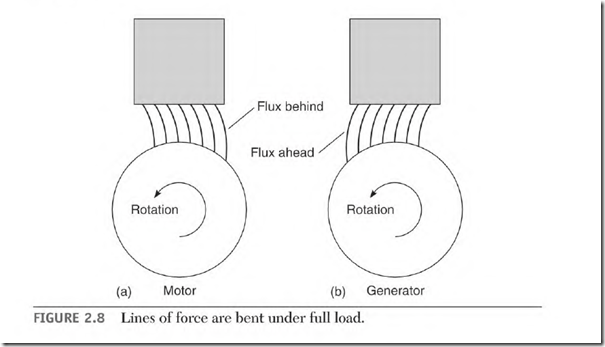The neutral location in the stator is a spot exactly between its poles. It’s 90 electrical degrees from each adjacent pole center. (Interpoles are placed in the neutral location.) The neutral spot in an armature iron is the teeth surrounding the slot or slots containing coils (that are shorted by a brush).
Whether using the DC kick method (see “Setting Neutral in a Generator”) or applying AC to the shunt field, the neutral location is found by checking the commutator’s bar-to-bar voltage. (The commutator will have little or no voltage bar to bar in the neutral location.) These bars are located where the voltage transformed into the armature windings from one stator pole is canceled by the voltage transformed by its adjacent stator pole.
When the machine is running, the brushes short the armature coil(s) located in this position. With idle coil(s) in this position, the armature teeth become a pole center, the same as with the pole iron of a shunt field coil (Fig. 2.8).
Setting Neutral in a Motor
Setting neutral in a motor can be done using a low-voltage voltmeter and 120 volts AC. (The AC voltage should be less than the shunt field’s voltage rating.)
FIGURE 2.8 Lines of force are bent under full load.
Attach the voltmeter to Al and A2 (armature leads) and apply the AC voltage to Fl and F2 (shunt field leads). Move the brush holder back and forth until the lowest voltage reading is found. Secure the brush holder at this spot. Most machines will not have a 0 voltage spot. (Voltage under
0.5 volt is acceptable.)
Black Band Adjustment
If possible, check the brush arcing at full load. (Further adjusting may be necessary.) The flux (lines of force) will deform as shown in Fig. 2.8. Move the brush holder one segment at a time against rotation (Fig. 2.8a) until there is the least amount of sparking. This is called the black band method of adjusting the brushes. The term black band doesn’t refer to a black band of any kind. Instead, it means the least amount of sparking, as opposed to the light that occurs with excessive sparking along the trailing edge of the brushes.
Setting Neutral in a Generator
To set neutral in a generator using the kick method, use a DC voltage source and a low-voltage voltmeter. The DC voltage should be no higher than the shunt field’s rating. Attach the low-voltage voltmeter to Al and A2. Attach the positive lead of the DC voltage source to Fl. Make and break the connection between the negative lead and F2.
As the brush holder is moved, the lowest voltmeter reading will indicate the unloaded neutral spot. Secure the brush holder at this position.
Use the black band method (described in the previous section) for the final setting. If the brushes arc when the generator is loaded, move the brush holder with rotation one segment at a time until arcing is acceptable (Fig. 2.8b).
Restoring Residual Magnetism
After Setting Neutral
AC voltage can be used to set the neutral in a generator, but the residual magnetism in the pole iron may become reversed, or demagnetized. If this method is used, apply DC voltage (no higher than the shunt field’s rating) for a few minutes, with the positive lead on Fl and the negative lead on F2. This will restore the residual magnetism in the pole iron to the right polarity.
A generator can be tested by running it as a motor. This test method will invariably reverse the residual magnetism in the generator’s pole iron. Use the preceding procedure to restore the right polarity in the pole iron.
Overheated Motor
When a motor has overheated to the point of smoking, it’s best to replace or rewind it. It should be inspected very carefully for burned windings. There will be a very distinct burned winding smell (that stays in the motor after it cools). The components that overheat are all in the armature circuit—the armature, the interpoles, and the series field. The shunt field may be damaged if the series field is wound on top of it.
Sometimes an overheated motor will operate for a long time. Therefore, it should be tested more frequently than normal. The fact that it was overheated should be recorded.
